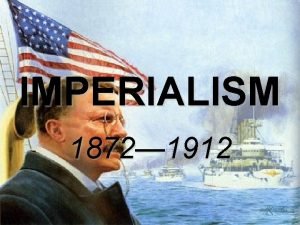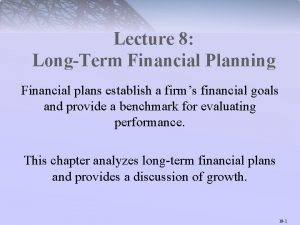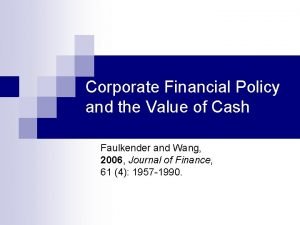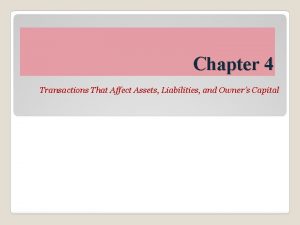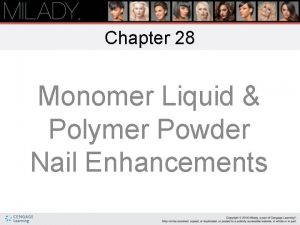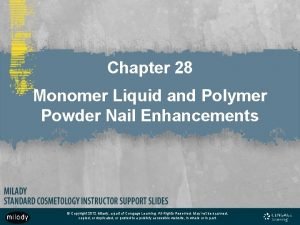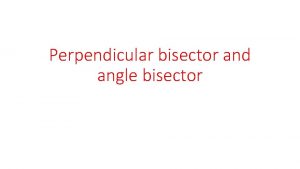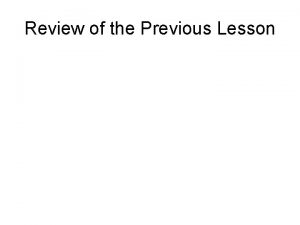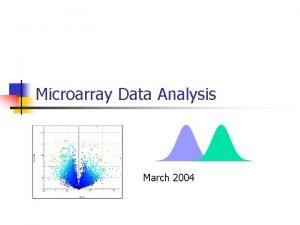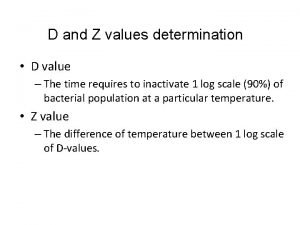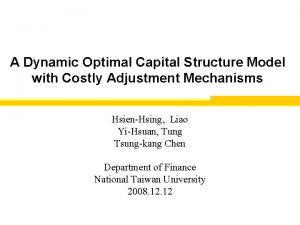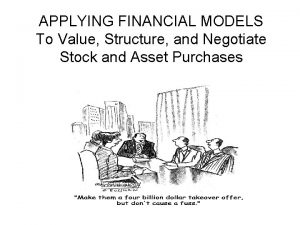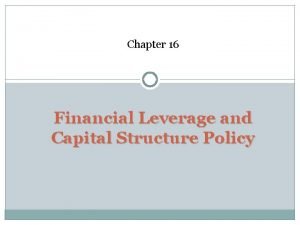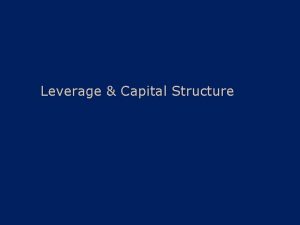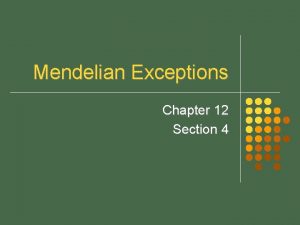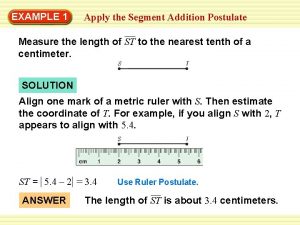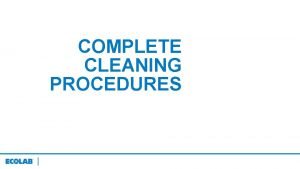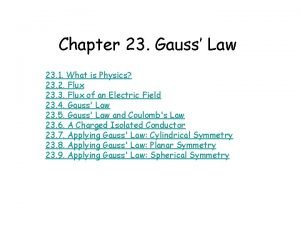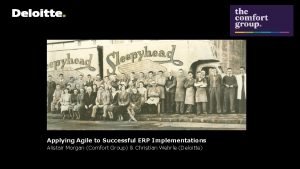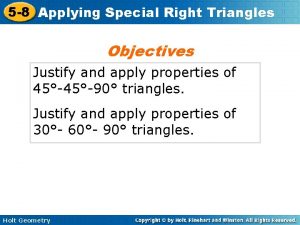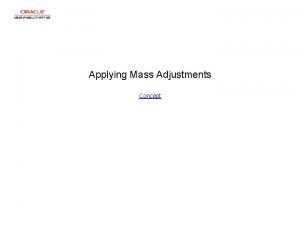APPLYING FINANCIAL MODELS To Value Structure and Negotiate















































- Slides: 47

APPLYING FINANCIAL MODELS To Value, Structure, and Negotiate Stock and Asset Purchases

Tact is for people not witty enough to be sarcastic. --Anonymous

Exhibit 1: Course Layout: Mergers, Acquisitions, and Other Restructuring Activities Part I: M&A Environment Part II: M&A Process Part III: M&A Valuation and Modeling Part IV: Deal Structuring and Financing Part V: Alternative Business and Restructuring Strategies Ch. 1: Motivations for M&A Ch. 4: Business and Acquisition Plans Ch. 7: Discounted Cash Flow Valuation Ch. 11: Payment and Legal Considerations Ch. 15: Business Alliances Ch. 2: Regulatory Considerations Ch. 5: Search through Closing Activities Ch. 8: Relative Valuation Methodologies Ch. 12: Accounting & Tax Considerations Ch. 16: Divestitures, Spin-Offs, Split-Offs, and Equity Carve-Outs Ch. 3: Takeover Tactics, Defenses, and Corporate Governance Ch. 6: M&A Postclosing Integration Ch. 9: Financial Modeling Techniques Ch. 13: Financing the Deal Ch. 17: Bankruptcy and Liquidation Ch. 10: Private Company Valuation Ch. 14: Applying Financial Models to Deal Structuring Ch. 18: Cross-Border Transactions

Learning Objectives • Through “hands on” application of the author’s M&A model, provide students with a basic understanding of – How such models work for a stock purchase and an asset purchase; – The data input requirements to generate critical model output – How to apply such models to address valuation, financing, and deal structuring questions; and – How they facilitate the assessment of proposals and counterproposals that arise during the negotiation process.

Financial Models Help Answer Key Valuation, Financing, and Deal Structuring Questions • • • Valuation – What are the key drivers of firm value? – How much is the target company worth without the effects of synergy? – What is the value of expected synergy? – What is the maximum price the acquirer should pay for the target firm? Financing – Can the proposed purchase price be financed? – What combination of potential sources of funds provides the lowest cost of funds for the acquirer, subject to existing loan covenants? Deal Structuring – What is the impact on financial performance and valuation if an acquirer is willing to assume certain target liabilities? – What is the impact on the acquirer’s earnings per share of alternative forms of payment? – What are the implications of a purchase of stock versus a purchase of assets? – What is the distribution of ownership of the combined businesses between acquirer and target shareholders following closing?

Stock Versus Asset Purchase • Stock purchases: – Statutory or direct merger: Acquirer and Target combine with one disappearing. Target shareholders receive cash or Acquirer stock for their shares. All target assets and liabilities transfer to Acquirer by “rule of law. ” – Cash-for-stock or stock-for-stock transactions: Acquirer buys Target stock directly from Target’s shareholders. If unable to buy all Target shares, Target becomes a partially owned Acquirer subsidiary. • Asset Purchases – Cash-for-assets acquisition: Acquirer pays cash for Target’s assets and may assume responsibility for some or all of Target’s liabilities. If enough Target assets have been acquired, the target may be liquidated. – Stock-for-assets transaction, Target shareholders receive Acquirer stock in exchange for the Target’s assets and assumed liabilities. In a second stage, Target dissolves leaving its shareholders with Acquirer stock.

M&A Model Overview Step 1: Construct historical financials and determine key factors (“value drivers) contributing to firm performance Step 2: Project target’s and acquirer’s financials and estimate their standalone values 1 M&A Valuation & Structuring Model (Summary Table) Step 3: Estimate value of combined firms (“Newco”), including synergy and deal terms Step 4: Determine appropriateness of offer price and Newco’s post-transaction capital structure 1 A standalone business is one which is not part of another firm and whose cash flows reflect revenue at current market prices and costs include all those required to generate the level of reported revenues.

M&A Model Value Drivers • Value drivers are variables which exert the greatest impact on firm value and include the following: – Revenue growth rate – Cost of sales as a percent of sales – S, G, &A as a percent of sales – WACC assumed during annual cash flow growth period (i. e. , planning period) – WACC assumed during terminal period – Growth rate assumed during terminal period.

M&A Model Worksheet Flow Diagram Valuation, EPS Impact, & Credit Ratios Deal Payment Terms Model Summary: Deal terms Form of Payment Sources/uses of funds EPS Impact Projected synergy Key credit ratios Valuation estimates Step 1: --Input Target and Acquirer historical financial statements --Determine key value drivers Step 2: -- Input forecast assumptions to project Target and Acquirer financial statements --Estimate standalone values Synergy Data Inputs Capital Structure Inputs Step 3: --Estimate synergy --Create Newco financials --Project financials including synergy & deal terms Step 4: Determine appropriateness of offer price and Newco posttransaction capital structure.

M&A Model Worksheets • • • Model Instructions Summary (Includes deal terms, sources/uses of funds, synergy estimates, EPS impact, and key credit ratios. ) Step 1: Input historical financial data and determine key value drivers – – • Step 2: Input Target and Acquirer forecast assumptions and estimate standalone values – – • Target and Acquirer Assumptions (enables projections of Target and Acquirer financial statements) Target and Acquirer IS (Income Statement—selected line item s only) Target and Acquirer BS (Balance Sheet—selected line items only) Target and Acquirer CF (Cash Flow—selected line items only) Step 3: Estimate value of Newco, including synergy & deal terms – – • Target and Acquirer Assumptions (historical data used to project financial statements) Target and Acquirer Income Statement (historical period only) Target and Acquirer Balance Sheet Statements (historical period only) Target and Acquirer Cash Flow Statements (historical periods only) Newco Assumptions (enables projections of combined firms financial statements) Newco IS (Income Statement) Newco BS (Balance Sheet) Newco CF (Cash Flow) Step 4: Determine appropriateness of offer price and Newco post-transaction capital structure – – – Debt Repayment (Includes repayment schedule for target debt assumed by the acquirer, the acquirer’s pretransaction debt), and new debt issued to finance the deal) Options-Convertibles (Estimates number of new target shares that must be acquired due to option conversion and the conversion of convertible debt and preferred equity. Valuation (Includes the valuation of target, acquirer, and Newco enterprise value, equity value and price per share. )

Model Balancing Mechanism • Financial models are in balance when total assets (TA) equal liabilities (TL) plus shareholders’ equity (SE). • The model balances automatically: – If TA > TL + SE (i. e. , a cash outflow), the firm borrows through its revolving loan facility (credit line) to finance the asset growth – If TA < TL + SE (i. e. , a cash inflow), the firm pays off any outstanding revolving loan balance with the cash inflow exceeding the minimum required cash balances

Input Versus Formula Model Cells • Cells containing formulas are in black • Cells highlighted in yellow are input cells – Changes to the content of these cells will fill in all cells containing formulas. – When replacing pre-existing data, it is helpful to change the color of those cells for which the data inputs have been made. • Red cells at the bottom of the balance sheet worksheets should be zero indicating the model is in balance.

Using the M&A Model • Step 1: Construct historical financial statements for Acquirer and Target and determine key value drivers • Step 2: Project Target and Acquirer financials and determine their standalone value • Step 3: Estimate the value of the combined firms (“Newco), including the effects of synergy & deal terms. • Step 4: Determine the appropriateness of the offer price and Newco’s post-transaction capital structure.

Step 1: Construct Historical Financial Statements and Determine Key Value Drivers a. Collect/analyze historical financials to identify key value drivers b. Normalize/smooth historical data (3 -to-5 years if possible) to identify long-term trends c. Input actual historical Target and Acquirer data into historical input cells of income statement, balance sheet, and cash flow statement worksheets

Target Historical Income Statement Sales Cost of Goods Sold Gross Profit SG&A Other Operating Expense Depreciation Amortization 2013 $ 3, 588. 1 1, 482. 0 2, 106. 1 1, 023. 2 470. 7 123. 0 299. 6 Actual 2014 $ 3, 775. 7 1, 665. 7 2, 110. 0 1, 009. 0 453. 2 123. 6 313. 9 EBIT Unusual (Gain) Loss (Income) from Affiliates Other Expense (Income) Interest Expense 189. 6 (37. 2) 60. 0 (4. 3) 152. 3 210. 3 - 10. 9 (3. 9) 162. 1 Earnings before Taxes 18. 8 Noncontrolling Interest Taxes - 63. 7 Net Income before Extra Items Extraordinary Items Net Income after Extra Items 2015 $ 3, 958. 5 1, 664. 1 2, 294. 4 1, 054. 6 414. 6 126. 0 302. 9 396. 3 - 11. 9 (2. 4) 123. 9 41. 2 262. 9 - 100. 9 - 101. 4 (44. 9) 0. 6 (59. 7) 0. 7 161. 5 0. 4 $ (44. 3) $ (59. 0) $ 161. 9

Step 2: Project Acquirer and Target Financials and Estimate Standalone Values a. Determine forecast assumptions for each key input variable 1. Revenue assumption drives cash flow growth 2. Determine using historical extrapolation or scenario “what if” analysis b. Input forecast assumptions into the model and project financials c. Select appropriate discount rate and terminal assumptions to estimate standalone values

Applying the 5 -Forces Model to Project Acquirer and Target Firm Financial Performance • How have the following factors affected revenue growth and profit margins in the acquirer and target firms’ industry historically? – Customers (size, number, price sensitivity) – Current competitors (market share, differentiation) – Potential entrants (entry barriers, relative costs) – Substitutes (availability, prices, switching costs) – Suppliers (size, number, uniqueness) • How will these factors change (if at all) to impact future revenue growth and profit margins of these firms? – Customers (size, number, price sensitivity) – Current competitors (market share, differentiation) – Potential entrants (entry barriers, relative costs) – Substitutes (availability, prices, switching costs) – Suppliers (size, number, uniqueness) Key questions: 1. How might changes in the bargaining power of customers and suppliers relative to the acquirer and target firms impact product pricing, costs, and profit margins? 2. How might substitutes and new entrants affect product pricing and profit margins?

Target Assumptions Worksheet Projections for the Period Ending December 31, Actual 2013 2014 2015 2016 2017 2018 2019 2020 Income Statement Sales Growth COGS as a % of Sales SG&A % annual increase (decrease) Other Operating Expense as a % of Sales NA 51. 3 % NA 18. 1% 52. 1% 16. 3% 27. 7% 46. 9% 27. 0% 8. 8. 1 4% 8% % EBITDA Growth NA EBITDA Margin 10. 6 % 10. 90. 8% 5% 9. 14. 9% 8% 27. 0% 0% 0% 51. 2% 2% 2% 20. 0% 0% 0% 8. 8. 8. 7% 7% 7% 5. 42. 40. 38. 36. 6% 8% 2% 3% 8% 12. 13. 15. 16. 18. 3% 9% 3% 7% 0% Key Point: Make small changes to assumptions one at a time to assess their impact on financial statements.

Practice Exercise 1 • Using the M&A Valuation & Deal Structuring Model accompanying this text: – On the Valuation worksheet, identify the enterprise and equity value of Target and Newco. – On the worksheet named Target Assumptions, increase the sales growth rate by 1% (i. e. , to 6. 5%). What is the impact on the Target’s and Newco’s enterprise and equity values? (Hint: See Valuation and Summary worksheets) – Click undo command to eliminate increase in sales growth rate or close model but do not save results 1 from Practice Exercise 1 Key Point: Impact of assumption changes on value observable on the Valuation and Summary Worksheets 1 This allows the model results to revert back to the “base” case and enables the model to be used in additional practice exercises.

Practice Exercise 2 • Using the M&A Valuation & Deal Structuring Model accompanying this text: – On the Valuation worksheet, identify the enterprise and equity values of Target and Newco? – On the worksheet named Target Assumptions, increase COGS (cost of goods sold) as a percent of sales by one percentage point (i. e. , . 43 to. 44). What is the impact on the Target’s and Newco’s enterprise and equity values? (Hint: See Valuation and Summary worksheets) – Click undo command to eliminate increase in cost of sales or close Model but do not save results from Practice Exercise 2 Key Point: Changes to key driver assumptions should be small and made one at a time to determine their impact on firm value.

Step 3: Estimate the Value of Newco, Including Synergy a. Estimate synergy and investment required to realize synergy b. Project Newco financials including effects of synergy and deal terms c. Select appropriate discount rate 1 and terminal period assumptions 1 The appropriate discount rate for the combined firm’s cash flows should be that associated with the Target if the Target is large relative to the Acquirer and its cash flows are viewed as riskier than those of the Acquirer.

Quick Quiz Which of the following is generally not considered a source of value to the acquiring firm? a. b. c. d. e. Duplicate facilities Patents Land on the balance sheet at below market value Warranty claims Copyrights

Summary Worksheet: Deal Terms Acquirer Transaction Summary ($Millions, except per share data) Transaction Value Form of Payment Sources & Uses Price Per Share $ 115. 0 % Stock 50. 0% Excess Cash $ 2, 500. 0 Target Shares Outstanding 51. 3 % Cash Common Shares Issued to 50. 0% Target Shareholders 3, 093. 8 Dilutive Effect of Stock Options Equity Consideration 2. 5 Target Preannouncement $ 6, 187. 7 Share Price Implied Purchase Price Premium Less: Cash $ 203. 9 Less: Equity in Affiliates Plus: Total Debt Plus: Noncontrolling Interests Less Other Adjustments Enterprise Value New Common Shares Issued Convertible Preferred $ 91. 14 Equity Revolving Credit 26. 2% Facility Shares % Current Shares 475. - Outstanding 5 77. 3% New Common Shares 139. 9. 1 Issued 4 22. 7% Convertible Preferred - Shares - Convertible Debt Senior Debt Subordinated Debt Total Sources - 5. 00% - 4. 0 0% - 4. 5 0% 593. 8 10. 0 0% - $ 6, 187. 7 - Equity Consideration $ 6, 187. 7 $ 5, 992. 9 New Warrants Issued - Transaction Expenses 5 yrs. - 614. Total Shares 9 100. 0% Total Uses $ 6, 187. 7

Newco Assumptions Worksheet Actual 2013 2014 Projections 2015 2016 2017 2018 2019 2020 Income Statement Sales Growth COGS as a % of Sales Integration Related Expenses ($M) NA 53. 3 % (0. 3 0. 3 %) % 53. 7 54. 3 % % 2. 9 % 5. 8 % 49. 0 76. 5 2. 4 % 37. 7 54. 3 71. 0 3. 0 % 45. 4 SG&A % annual increase NA Other Operating Expense as a % of Sales - - (10. 2 (18. 6 EBITDA Growth NA %) %) 14. 4 13. 0 10. 6 EBITDA Margin % % % 7. 7 3. 9 3. 6 4. 0 % % % 56. 1 54. 7 53. 5 53. 4 53 % % % 500. 250. 0 0 5. 4 5. 0 5. 1 % % % 0. 6 0. 7 0. 9 1. 1 % % % (12. 2 8. 4 10. 1 (1. 5 %) % % %) % 8. 6 9. 0 9. 6 9. 1 % % % Balance Sheet Receivable Days Inventory Days Oth Cur Assets % of Sales Days in Accounts Payable 53. 3 84. 6 2. 5 % 33. 4 52. 2 86. 9 2. 6 % 41. 8 52. 0 88. 3 2. 6 % 42. 0 51. 9 89. 9 2. 5 % 42. 3 51. 7 91. 8 2. 5 % 42. 7 4 9 % 1

Summary Worksheet: Newco Synergy Inputs SG&A Synergies Gross Margin Improvement $'s % Incremental Sales Synergy $'s Margin $'s 2016 $20. 0 2016 0. 12% $25. 0 2016 2017 25. 0 2017 0. 23% 50. 0 2017 4 3. 9% 100. 0 4 5. 3% 250. 0 2018 4 6. 5% 250. 0 2019 4 6. 6% 250. 0 2020 4 6. 6% 250. 0 2018 25. 0 2018 2019 25. 0 2019 2020 0. 23% 0. 22% 25. 0 2020 0. 21%

Newco Income Statement Worksheet Actual 2015 Sales Projected 2016 Acquirer Trans Target Adj $1, 389. $19, 062. 0 $19, 347. 9 3 Cost of Goods Sold Gross Profit 8, 708. 0 Other Operating Expense 6, 693. 0 10, 447. 9 8, 900. 0 2018 2019 2020 71 3 11, 690. 11, 844. 11, 994. 12, 465. 13, 022 1. 3 1. 1 3 7 7 7 8 67 8. 0 9, 146. 9, 807. 10, 428. 10, 861. 11, 376 9 8 8 7 4 6, 960. 7 - 38 (1 7, 336. 7, 702. 8, 084. 8, 496. 8, 94 5. 7 0. 0) 4 0 1 3 8 12 0. 9 309. 4 6 1. 7 Depreciation 342. 0 Amortization 85. 0 - EBIT 2017 500. 250. 0. 0 0 0 SG&A 10, 354. 0 2016 Projections $100. $20, 837. $23, 327. 0 2 $21, 652. 5 $22, 423. 4 4 $24, 399. 3 Integration Expenses Pro Forma 1, 629. 1, 588. 0 8 12 9. 7 120. 153. 194. 247. 9 5 9 6 4 351. 367. 386. 409. 2 1 1 1 0 - - 112. 0 0 1, 338. 1, 473. 1, 651. 1, 596. 1, 570. 4 2 6 7 2

Practice Exercise 3 • Using the M&A Valuation & Deal Structuring Model accompanying this text: – On the Valuation worksheet, identify the enterprise and equity values for Newco. – On the Summary worksheet under Incremental Sales Synergy, increase incremental revenue to $200 million in the first year, $250 million in the second year and $350 in the third year. What is the impact on Newco’s enterprise and equity values? (Hint: See Valuation worksheet) – Click undo command to eliminate increases in incremental sales revenue or close model but do not save results from Practice Exercise 3 Key Point: Synergy is generally realized gradually and requires some investment to realize full potential.

Step 4: Determine Appropriateness of Offer Price & Post-Transaction Capital Structure a. Is the offer price appropriate? : --Compare offer price with estimated maximum price and the offer price multiple with recent comparable deals --Determine if the deal will allow Newco to meet or exceed required returns (i. e. , NPV ≥ 0)1 b. Is the post-transaction capital structure sustainable? : --Compare projected Newco credit ratios and industry average credit ratios --Determine impact of deal on Newco EPS and current Newco loan covenants 1 NPV = PV Newco (including synergy) – Offer Price (including transaction expenses) ≥ 0

Determining the Offer Price PVMIN = PVT or MVT, whichever is greater. MVT is Target’s current share price times the number of shares outstanding PVMAX = PVMIN + PVNS, PVNS (net synergy) = PV (sources of value) – PV (destroyers of value) PVOP (offer price) = PVMIN + 1 PVNS, where 0 1 Offer price range for Target = (PVT or MVT) < PVOP < (PVT or MVT) + PVNS Key Point: Offer price lies between the minimum and maximum prices 1 Alpha ( ) is that portion of the PV of net synergy paid to Target shareholders.

Determining the Offer Price, Premium, and Purchase Price Multiple: An Example Assumptions: Target’s pre-deal price per share = $18 Target shares outstanding = 5 million Target’s current earnings per share = $2. 20 Target’s minimum (standalone or market) value = $100 million PV of net synergy = $20 million Alpha ( ) = 50% Offer Price, Premium, and Purchase Price Multiple: Offer price per share = (Target’s minimum value + x PVnetsynergy) / Target shares outstanding = ($100 million +. 5 x $20 million) / 5 million = $22 Offer (purchase) price premium = $22/$18 = 22. 2% Offer (purchase) price multiple = $22 / $2. 20 = 101 1 Offer price multiple, in this instance measured as a P/E ratio, can be compared to P/E ratios for recent comparable transactions to determine the reasonableness of the premium.

Summary Worksheet (Performance Metrics): Newco EPS, Valuation & Key Credit Ratios Earnings per Share 2016 P $ 2. 42 $ 1. 39 2016 P $ 2. 65 $ 5. 64 2005 P 2017 P $ 2. 19 $ 1. 74 2017 P $ 2. 97 $ 2. 34 2017 P 2018 P $ 1. 94 $ 1. 96 2018 P $ 2. 73 $ 2. 60 2018 P 2019 P $ 1. 67 $ 1. 90 2019 P $ 2. 47 $ 2. 70 2019 P 2020 P $ 1. 39 $ 1. 87 2020 P $ 2. 20 $ 2. 71 2020 P Valuation Acquirer Newco Present Value $'s Cash EPS Acquirer Newco Total Debt to Total Capital Accretion / (Dilution) EPS (42. 5 %) (20. 2 %) 1. 2 % 13. 6 % 34. 5 % Cash EPS 112. 9 % (21. 2 %) (4. 8 %) 8. 9 % 23. 1 % Newco Interest Coverage (EBITDA to Interest Expense) Target $ 5, 590. 7 2016 P 5. 7% 2016 P 44. 6 x Acquirer 36, 330. 3 2017 P 5. 0% 2017 P 56. 5 x Newco 48, 110. 8 2018 P 4. 2% 2018 P Synergies 6, 189. 8 2019 P 3. 6% 2019 P Newco Terminal Value/Enterprise Value 77. 0% 2020 P 3. 0% 2020 P 68. 9 x 76. 0 x 86. 4 x

Summary Worksheet: Deal Financing Acquirer Transaction Summary ($Millions, except per share data) Transaction Value Form of Payment Sources & Uses Price Per Share $ 115. 0 % Stock 50. 0% Excess Cash $ 2, 500. 0 Target Shares Outstanding 51. 3 % Cash Common Shares Issued to 50. 0% Target Shareholders 3, 093. 8 Dilutive Effect of Stock Options Equity Consideration 2. 5 Target Preannouncement $ 6, 187. 7 Share Price Implied Purchase Price Premium Less: Cash $ 203. 9 Less: Equity in Affiliates Plus: Total Debt Plus: Noncontrolling Interests Less Other Adjustments Enterprise Value New Common Shares Issued Convertible Preferred $ 91. 14 Equity Revolving Credit 26. 2% Facility Shares % Term Debt Current Shares 475. - Outstanding 5 77. 3% Subordinated Debt New Common Shares 139. 9. 1 Issued 4 22. 7% Total Sources Convertible Preferred - Shares - - Convertible Debt - Equity Consideration - 5. 00% - 4. 0 0% - 4. 5 0% 593. 8 10. 0 0% - $ 6, 187. 7 $ 5, 992. 9 New Warrants Issued - Transaction Expenses 5 yrs. - 614. 9 100. 0% Total Uses $ 6, 187. 7 Total Shares

Newco Balance Sheet Worksheet Actual 2015 Acquirer Target Cash $ 4, 938. 0 $ 203. 9 Accounts Receivable 2, 838. 0 102. 0 Inventory 2, 015. 0 215. 4 Other 563. 0 Current Assets Pre-Trans Adj Trans Adj $ (2, 500. 0) Pro Forma 2015 Projections 2016 2017 $ 2, 641. 9 $ 5, 236. 2 $ 5, 704. 6 2, 940. 0 2, 979. 5 3, 087. 7 2, 230. 4 138. 6 138. 4 19. 3 582. 3 533. 4 552. 3 10, 354. 0 540. 6 8, 394. 6 8, 887. 7 9, 482. 9 Property, Plant, & Equipment 4, 906. 0 162. 9 - 5, 068. 9 5, 504. 4 5, 953. 8 Accumulated Depreciation (2, 791. 0) (86. 8) - (2, 877. 8) (3, 229. 0) (3, 596. 2) Net Property, Plant, & Equipment 2, 115. 0 76. 1 2, 191. 1 2, 275. 3 2, 357. 6 Goodwill 205. 0 - 5, 895. 7 5, 883. 7 5, 871. 7 Intangible Assets 487. 0 3. 9 490. 9 390. 9 290. 9 Deferred Taxes 1, 184. 0 36. 6 1, 220. 6 1, 275. 6 1, 330. 6 Other 53. 0 18. 2 71. 2 Total Assets $ 14, 398. 0 $ 675. 4 $ 18, 264. 1 $ 18, 784. 4 $ 19, 404. 9 Accounts Payable 1, 289. 0 84. 7 1, 373. 7 1, 339. 2 1, 364. 5 Other 2, 069. 0 64. 4 2, 133. 4 2, 279. 2 2, 295. 5 Current Liabilities 3, 358. 0 149. 1 3, 507. 1 3, 618. 4 3, 660. 0 Senior Debt 276. 0 9. 1 593. 8 878. 9 804. 7 730. 5 Subordinated Debt - - Total 276. 0 9. 1 878. 9 804. 7 730. 5 Deferred Taxes 910. 0 - 910. 0 944. 0 978. 0 Other 11. 0 20. 2 31. 2 Total Liabilities 4, 555. 0 178. 4 5, 327. 2 5, 398. 3 5, 399. 7 Common Stock 3, 947. 0 225. 0 2, 868. 8 7, 040. 8 Retained Earnings 5, 801. 0 270. 0 (270. 0) 5, 801. 0 6, 250. 2 6, 869. 4 Other Adjustments 95. 0 2. 0 (2. 0) 95. 0 Total Stockholders Equity 9, 843. 0 497. 0 12, 936. 8 13, 386. 1 14, 005. 2 Total Liabilities and Equity $ 14, 398. 0 $ 675. 4 $ 18, 264. 1 $ 18, 784. 4 $ 19, 404. 9 - 5, 690. 7 #

Practice Exercise 4 • Using the M&A Valuation & Deal Structuring Model accompanying this text: – On the Summary worksheet under the Sources and Uses heading, note how the purchase price is financed. – Under the heading Form of Payment, change the composition of the purchase price to 100% cash. Assume the purchase price is partially financed by reducing Acquirer excess cash by $1 billion and by raising $4 billion by issuing new Acquirer equity to the public. Under the Sources and Uses heading, how is the remainder of the purchase price financed? – Change the composition of the purchase price to 100% equity, what is the impact on how the purchase price is financed? – Click undo command to eliminate changes to base case model or close model but do not save the results from Practice Exercise 4 Key Point: How a deal is financed reflects: form of payment (share exchange requires new Acquirer shares), that combination of sources of funds resulting in the lowest average cost of funds, and the impact on Newco EPS and current loan covenants,

Practice Exercise 5 Using the M&A Deal Structuring Model accompanying this text: On the Summary worksheet under the Valuation heading (lower left hand corner of worksheet), note the net present value of Newco including synergy (last row of worksheet). On the Valuation worksheet, increase Newco’s terminal value growth rate by one percentage point and reduce the discount rate by one percentage point (lower left hand corner) and enter the new values. How do these changes in the Newco terminal value assumptions affect Newco’s net present value including synergy on the Summary worksheet? Click undo command to eliminate changes to the base case model or close model but do not save the results from Practice Exercise 5 Key Point: Small changes in terminal value assumptions result in disproportionately large changes in firm value.

Calculating Offer Price Per Share and Target’s Equity Value Under Alternative Payment Scenarios All Stock Transaction: Offer Price Per Share = Share Exchange Ratio 1 x Acquirer’s Share Price = Offer Price Per Share x Acquirer’s Share Price Acquirer’s Share Price Equity Value = Offer Price Per Share x Target’s Fully Diluted Shares Outstanding 2 All Cash Transaction: Offer Price Per Share = Cash Offer Per Target Share Equity Value = Cash Offer Per Target Share x Target’s Fully Diluted Shares Outstanding Cash and Stock Transaction: Offer Price Per Share = Cash Offer Per Share + (Share Exchange Ratio x Acquirer’s Share Price) Equity Value = [Cash Offer Per Share + (Share Exchange Ratio x Acquirer’s Share Price)] x Target’s Fully Diluted Shares Outstanding 1 When share exchange ratios (SERs) are fixed, the value of the transaction can change due to fluctuations in the acquirer’s share price. Assume the SER is 2 and the acquirer’s share price is $50, the offer price per share is $100. However, if the acquirer’s share price falls to $40 or increases to $60 before closing, the offer price is $80 and $120, respectively. Under a floating SER, the dollar value of the offer price per share is fixed and the number of shares exchanged varies with the value of the acquirer’s share price. Acquirer share price changes require re-estimating the SER. For example, if the acquirer’s share price falls to $40, the number of new acquirer shares issued per target share to preserve the $100 offer price is 2. 5 (i. e. , $100/$40); if the acquirer’s share price rises to $60, the new SER would be 1. 6667 (i. e. , $100/$60). Fixed SERS are most common because the risk of changes in the offer price is shared equally by the acquirer (i. e. , if acquirer’s share price rises) and the target (i. e. , if the acquirer’s share price falls). 2 Fully diluted shares represent the total number of Target shares outstanding if all options, convertible preferred and debt outstanding were converted into Target common shares.

Calculating Post-Merger EPS in a Cash & Stock Transaction: Practice Exercise 6 Assume the offer or purchase price determined through negotiation is $84. 30 for each Target share and consists of 1 share of Acquirer stock (i. e. , $56. 25) and $28. 05 (i. e. , $84. 30 offer price - $56. 25) in cash. Furthermore, assume that the cash portion of the purchase price is financed by the acquirer at an 8% annual interest rate with the principal due in 10 years. The firm’s marginal tax rate is 40%. What is the earnings per share of the combined businesses after closing? Pre-Merger Data Acquirer Target Net Earnings $281, 500, 000 $62, 500, 000 Shares Outstanding 112, 000 18, 750, 000 EPS $2. 51 $3. 33 Market Price Per Share $56. 25 $62. 50

Calculating the Target’s Fully Diluted Shares Outstanding and Adjusting Equity Value (If Converted Method) Assumptions about Target Comment Basic Shares Outstanding 2, 000 In-the-Money Optionsa 150, 000 Exercise Price = $15/share Convertible Debentures (Face value = $10, 000 $1000; convertible into 50 shares of common stock; implied conversion price = $20 (i. e. $1000/50)) Number of Debentures outstanding = $10, 000/$1, 000 = 10, 000 If fully converted = 10, 000 x 50 = 500, 000 common shares Preferred Stock (Par value = $60; $5, 000 convertible into 3 common shares; implied conversion price = $20 (i. e. , $60/3)) Preferred shares outstanding = $5, 000 / $60 = 83, 333 If fully converted = 83, 333 x 3 =250, 000 common shares Offer Price Per Share Purchase price offered for each target share outstanding $30 Total Shares Outstandingb = 2, 000 + 150, 000 + 500, 000 + 250, 000 = 2, 900, 000 Adjusted Target Equity Valuec = 2, 900, 000 x $30 -150, 000 x $15 = $87, 000 - $2, 250, 000 = $84, 750, 000 a. An option whose exercise price is below the market value of the firm’s share price. c. Total shares Outstanding = Issued Shares + Shares from “in the money” options and convertible securities. d. Purchase price adjusted for new acquirer shares issued for convertible shares or debt less cash received from “in the money” option holders. Key Point: Actual purchase price is $84. 8 million rather than $60 million.

Calculating Fully Diluted Shares Outstanding: Options Outstanding (Mil. of Shares) Strike Price In the Money Number Likely to be Converted 4. 045 $37. 46 Yes 4. 045 Assumptions: Current Target Share Price = Offer Price = $82/share Proceeds from Option Holders used to repurchase Target shares at current Target share price New Target Shares from Option Conversion: What firm has to pay to repurchase new Target shares: $82 x 4. 045 = $331. 69 What firm receives from converting option holders: $37. 46 x 4. 045 = $151. 53 Difference = $180. 16 New Target shares issued = [Cost to Repurchase All Shares Converted – Proceeds from Converting Option Holders] / Current Target Share Price = $180. 16 / $82 = 2. 1971

Calculating Fully Diluted Shares Outstanding: Convertible Debt Principal (Millions) Par Value $. 44 $1000 Conversion Ratio Price 20 $50 Likely to Convert New Shares Yes . 0088 Assumptions: Current Target share price = offer price = $82/share New Target Shares Issued: Conversion Ratio (CV) = Number of target common shares when debt converted at par value = 20 CV Price = Par Value / CV Ratio = $1000/20 = $50 New Target Shares = ($. 44 / $1000) x 20 =. 0088 (i. e. , 88, 000 shares) Key Point: Add new shares issued to Target’s basic shares outstanding.

Calculating Fully Diluted Shares Outstanding: Convertible Preferred Balance Par Value CV Ratio CV Price Likely to Convert New Shares $3. 40 $100 1. 7 $57. 14 Yes . 0595 Assumptions: Current Target share price = offer price = $82/share New Shares Issued: Conversion Ratio (CV) = number of new Target shares when converted at par value = 1. 75 CV Price = $100 / 1. 75 = $57. 14 New Target Shares Issues = )$3. 40 / $100) x 1. 75 =. 0595 (i. e. , 59, 500 shares) Key Point: Add new shares issued to Target’s basic shares outstanding

Modeling An Asset Purchase • As with a stock purchase model, asset purchases begin with the estimation of Target’s enterprise value. 1 • Enterprise value is then adjusted by subtracting Target assets excluded from the deal (Aexcl) and Target liabilities included in the deal (Linc). The end result is referred to as net acquired assets. Net Acquired Assets = TA – Aexcl – Linc = Aincl – Linc where Aincl equals Target assets included in the deal. • The purchase price is what Acquirer pays for net acquired assets and is often expressed as a multiple of net book assets (i. e. , book assets less book liabilities). 1 Recall that enterprise value can be viewed from either the asset side (total assets) or the liability side (total liabilities plus equity) of the balance sheet. In the context of an asset purchase, enterprise value equals total Target assets. TA = Aexcl + Aincl = Lexcl + Lincl + EQ and Aincl – Lincl = Lexcl – Aexcl + EQ, where EQ = Target shareholders’ equity and Ainc – Lincl = Net acquired assets by Acquirer.

Asset Purchase Illustration • Assume that Acquirer pays $90 million to purchase $75 million in net acquired assets, consisting of $100 million of Target net property, plant and equipment (i. e. , Net PP&E) less assumed Target current liabilities of $25 million and that the book values of Target assets and liabilities are equal to their fair market value. • The purchase is financed by using $20 million in Acquirer pretransaction cash balances and by borrowing $70 million in long-term debt. • Synergies in the first year include a reduction in cost of sales of $5 million. First year integration expenses are $15 million. • The implied purchase price multiple is 1. 2 times net acquired assets (i. e. , $90 million/$75 million).

Asset Purchase: Acquirer Income Statement Adjustments

Asset Purchase: Acquirer Balance Sheet Adjustments Table 9. 12 Acquirer Balance Sheet: Asset Purchase Cash Current Assets (Excl. Cash) Net Property, Plant & Equipment Goodwill Other Long-Term Assets Total Assets Current Liabilities Long-Term Debt Other Long-Term Liabilities Total Liabilities Common Stock Preferred Equity Retained Earnings Other Adjustments Total Shareholders‘ Equity Total Liabilities and Equity Actual Trans Pro Forma 2015 Adj. 2016 Acquirer Pre-Deal $125. 00 Adj. Acquirer Post-Deal ($20. 00) $105. 00 550. 00 1, 250. 00 450. 00 $2, 375. 00 550. 00 450. 00 375. 00 1, 375. 00 500. 00 50. 00 400. 00 50. 00 375. 00 1, 470. 00 50. 00 400. 00 50. 00 1, 000. 00 $2, 375. 00 $2, 470. 00 100. 00 15. 00 1, 350. 00 15. 00 25. 00 70. 00 450. 00 $2, 470. 00 575. 00 520. 00

Asset Purchase: Acquirer Cash Flow Statement Adjustments 2015 Ending Cash used to finance PP&E Purchase 2016 Beginning Cash Balance Cash from Operations Net Income Depreciation (Gain)/Loss Current Assets Current Liabilities Net cash flow from Operations Cash from Investing PP&E Acquisition Net cash flow from Investing Cash from Financing Increase in Debt Net Cash Flow from Financing Net Cash Flow Ending Cash Balance $125. 00 (20. 00) $105. 00 (1. 20) 0. 00 (10. 00) 0. 00 25. 00 13. 80 (90. 00) 70. 00 (6. 20) $98. 80

Things to Remember… • Financial modeling facilitates the process of valuation, deal structuring, and selection of the appropriate financing plan. • The process entails the following four steps: – Step 1: Construct historical financial statements for Acquirer and Target and determine key value drivers – Step 2: Project Target and Acquirer financials and determine their standalone value – Step 3: Estimate the value of the combined firms (“Newco), including the effects of synergy & deal terms. – Step 4: Determine the appropriateness of the offer price and Newco’s post-transaction capital structure.
 Williams and fudge payment
Williams and fudge payment Spanish politeness
Spanish politeness How audience negotiate meaning in mil
How audience negotiate meaning in mil Negotiating with sap
Negotiating with sap Job how negotiate salary
Job how negotiate salary What is media literacy
What is media literacy Contoh value creation
Contoh value creation Difference between modals and semi modals
Difference between modals and semi modals Financial planning models
Financial planning models Financial methods of motivation
Financial methods of motivation Khushhali bank karobar loan
Khushhali bank karobar loan Corporate financial policy and the value of cash
Corporate financial policy and the value of cash Chapter 33 applying paints and enamels
Chapter 33 applying paints and enamels Assets increase on which side
Assets increase on which side The nail extension underside should:
The nail extension underside should: As monomer liquid absorbs polymer powder
As monomer liquid absorbs polymer powder 17:6 providing first aid for burns
17:6 providing first aid for burns Perpendicular bisectors
Perpendicular bisectors Valrox
Valrox Pvalue formula
Pvalue formula D value and z value
D value and z value Acid value principle
Acid value principle Capturing value from customers
Capturing value from customers What are the models of urban structure
What are the models of urban structure Capital structure models
Capital structure models The models of the church
The models of the church Deal structure models
Deal structure models Financial leverage and capital structure policy
Financial leverage and capital structure policy Degree of total leverage
Degree of total leverage Andalusian chicken incomplete dominance
Andalusian chicken incomplete dominance Literary criticism approaches
Literary criticism approaches Applying mendel's principles
Applying mendel's principles Applying angle relationships homework 2
Applying angle relationships homework 2 Segment addition postulate
Segment addition postulate Formalist approach literature
Formalist approach literature Food mixer
Food mixer Light cured gel enhancements rely on ingredients from the
Light cured gel enhancements rely on ingredients from the Gauss law
Gauss law 11.2 applying mendel's principles
11.2 applying mendel's principles Applying the pythagorean theorem homework 3
Applying the pythagorean theorem homework 3 Applying properties of similar triangles
Applying properties of similar triangles Examples of social learning theory in healthcare
Examples of social learning theory in healthcare Applying agile approach in erp implementation
Applying agile approach in erp implementation Advice for applying machine learning
Advice for applying machine learning Lesson 5-8 applying special right triangles
Lesson 5-8 applying special right triangles 5-8 applying special right triangles
5-8 applying special right triangles Simplest radical form of 45
Simplest radical form of 45 Special right triangles (radical answers)
Special right triangles (radical answers)

